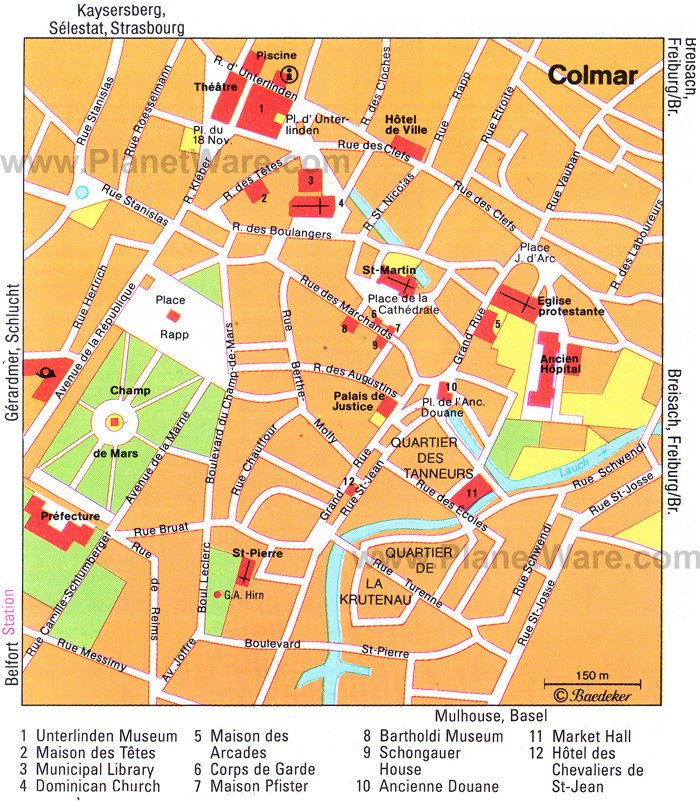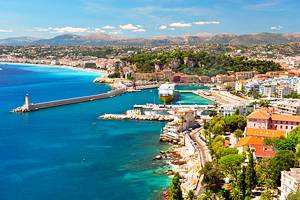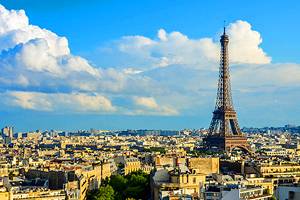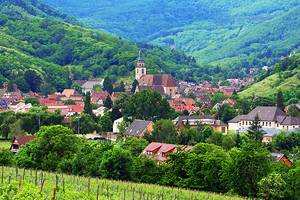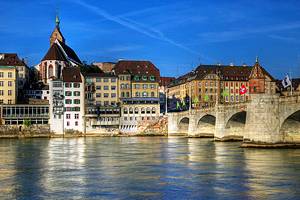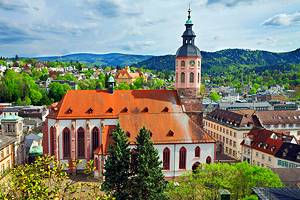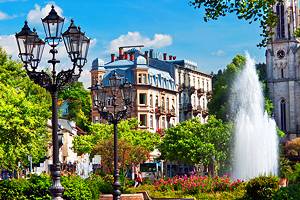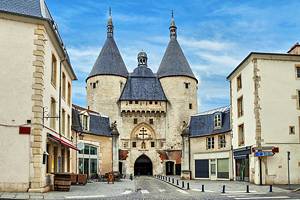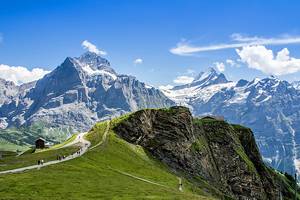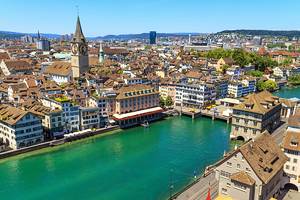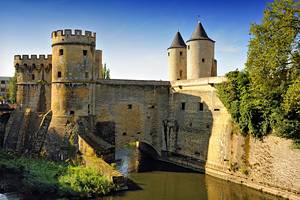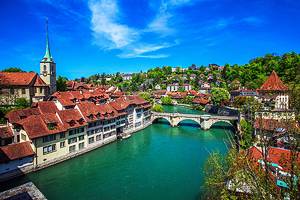Tourist Attractions in Colmar
Amid the vine-covered foothills of the southern Vosges Mountains, the picturesque town of Colmar offers an exceptional wealth of historic attractions. Colmar exudes a special old-world ambience, as it has remained relatively unchanged over the centuries. Wandering the ancient quarters takes you on a journey back in time.
During the medieval era, Colmar was an important marketplace, as well as a center of art and learning. The fascinating cultural heritage is visible in the town's historic residential buildings, as well as in the Catholic, Protestant, and Dominican houses of worship.
Colmar is one of the most quintessential Alsatian towns. You'll discover its charms in the Old Town's atmospheric pedestrian streets and canal-side neighborhoods. Everywhere you turn, you'll be dazzled by traditional Alsatian half-timbered houses, painted in candy colors and decorated with potted flowers.
This captivating town is the perfect place to visit to start exploring the Alsace region. Find the best things to do with our list of the top tourist attractions in Colmar.
- Old Town & Place de la Cathédrale
- Musée Unterlinden
- Eglise des Dominicains
- Koïfhus (Ancienne Douane)
- Quartier de la Krutenau (La Petite Venise)
- Quartier des Tanneurs
- Quai de la Poissonnerie
- Eglise Saint-Martin
- Eglise Saint-Matthieu
- Musée du Jouet de Colmar
- Ancien Corps de Garde (Former Guard House)
- Chapelle Saint-Pierre
- Festival International de Colmar
- Map of Tourist Attractions in Colmar
Old Town & Place de la Cathédrale
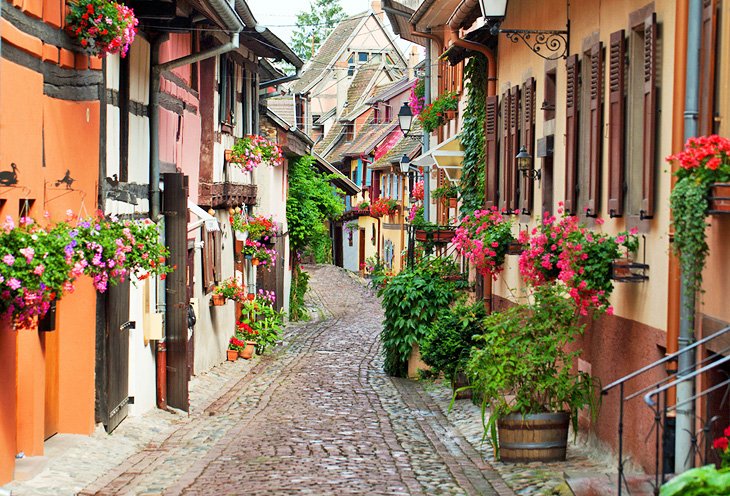
Seemingly right out of a storybook, the Old Town (Vieille Ville) of Colmar is a maze of winding cobblestone streets lined with typical Alsatian burghers' houses. This well-preserved historic center of town lies between the Rue des Têtes, the Rue des Clefs, and the Rue des Marchands near the Place de la Cathédrale.
The Quartier de la Krutenau and the Quartier des Tanneurs could also be considered part of the Old Town. However, the following description focuses on the center of the historic district.
You may begin a tour of Colmar at the Place de la Cathédrale, the very heart of Colmar's Old Town. On this square is the Collégiale Saint-Martin (Saint-Martin Collegiate Church), originally a Gothic church that was largely rebuilt in the 18th century.
Another historic monument on the Place de la Cathédrale is the Ancien Corps de Garde (Former Guard House) which has served many purposes, from a marketplace building to a justice hall and military housing. This historic edifice is a jewel of Alsatian Renaissance architecture.
The Maison Adolph also graces the square at 16 Place de la Cathédrale. Built in 1350 for the Adolph family, this lovely house is one of the oldest buildings in Colmar. Next to the Maison Adolph is a well featuring two lion heads that dates to 1592.
Continue sightseeing on the Grand Rue (a short walk away) and visit the Eglise Saint-Matthieu, a 13th-century Protestant church. A must-see attraction nearby is the Maison Pfister (11 Rue des Marchands), which dates to 1537 and is one of the first houses in Colmar to reveal elements of Renaissance architecture.
Steps away from the Maison Pfister, the Musée Bartholdi (30 Rue des Marchands) displays mementos of the famous sculptor Auguste Bartholdi. Nearby, the Rue des Boulangers (Bakers' street) and the Rue des Serruriers (Locksmiths' Street) are lined with attractive half-timbered buildings that house enticing little boutiques and cafés.
One of the most interesting places to visit in the Old Town is La Maison des Têtes at 19 Rue des Têtes. This ornate Renaissance building features a facade decorated with over a hundred different personages (small busts) sculpted from stone.
Listed as Monument Historique and restored in 2012, La Maison des Têtes has been converted into a five-star Relais & Châteaux hotel with modern guest rooms; a traditional Alsatian brasserie (Restaurant des Têtes); and a Michelin-starred fine-dining establishment, the Restaurant Girardin.
Musée Unterlinden
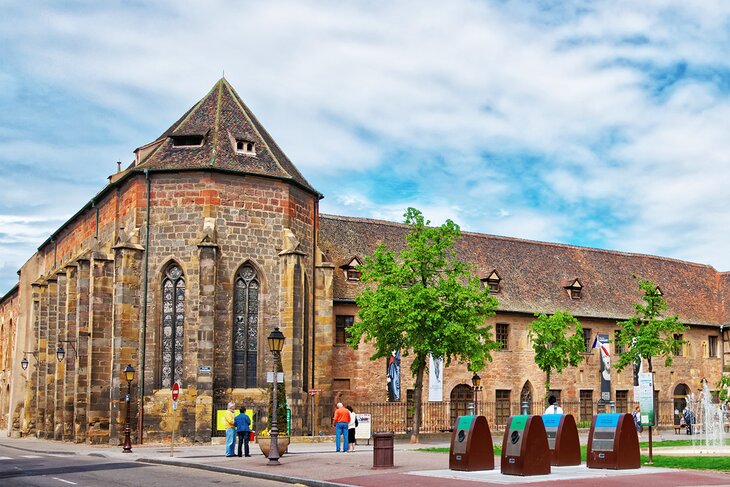
This exceptional museum presents a diverse assortment of artworks in a 13th-century edifice (that was once a Dominican convent). The building is especially noteworthy for its beautifully preserved double-arcaded cloister. In 2015, the museum expanded its gallery space with an adjoining building that occupies the town's former municipal baths.
The Unterlinden Museum displays an extensive collection of Romanesque and Gothic sculptures, medieval religious paintings, folk art and crafts, and decorative objects. The museum's 20th- and 21st-century art collection includes works by Claude Monet, Pierre Bonnard, Fernand Léger, Maurice Denis, Nicolas de Staël, and Pablo Picasso.
One of the highlights of the museum is the Isenheim Chapel, which contains fine paintings by early German artists. The chief treasure of the chapel is the Retable d'Issenheim (Altarpiece of Issenheim), a masterpiece of religious art created around 1515 for the high altar of the Isenheim monastery (located near Guebwiller).
The museum's Café-Restaurant Schongauer serves refreshments, meals, and pâtisserie in a contemporary-style dining room or at the pleasant outdoor patio of a tree-lined courtyard. The museum also has a boutique that sells art-themed books and gift items.
Museum hours are 9am until 6pm Wednesday through Monday year-round; the museum is closed on Tuesdays. The Café-Restaurant Schongauer is open from 10am until 5pm Wednesday through Sunday year-round; the café-restaurant is closed on Mondays and Tuesdays.
Address: 1 Rue d'Unterlinden, Colmar
Eglise des Dominicains
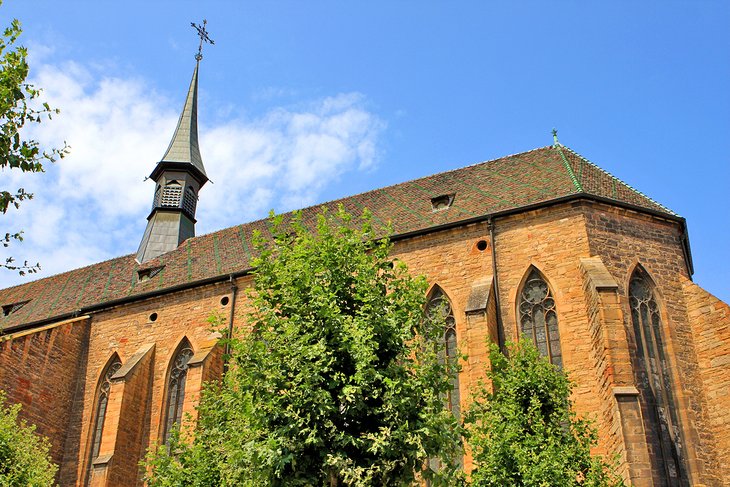
Simple and serene, the 14th-century Eglise des Dominicains exemplifies early Gothic architecture. Enter the church to admire the narrow high-vaulted nave, adorned with exquisite works of art. Splendid stained-glass windows allow light to flow into the sanctuary and offer inspiration to worshipers.
The choir displays the famous Vierge au Buisson de Roses, a masterpiece created by the atelier of Martin Schongauer in 1473.
The church was founded by Dominican preachers, who contributed to the interest in mystical philosophy during the 14th and 15th centuries.
From the Dominican Church, it is a short walk to the Rue des Clefs, the main shopping street of Colmar's Old Town.
The church is open for touristic visits on Tuesdays, Thursdays, Fridays, Saturdays, and Sundays from March 25th through December 26th.
Address: Place des Dominicains, Colmar
Koïfhus (Ancienne Douane)
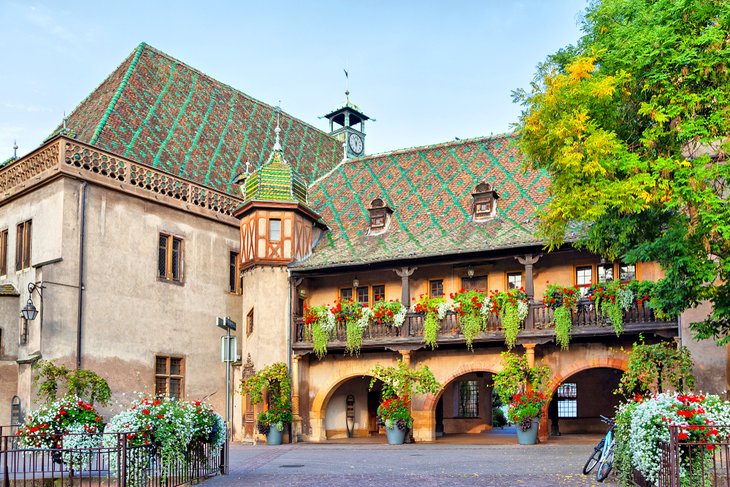
Near the Place du Marché-aux-Fruits (the site of the old fruit market) and at the intersection of the Grand Rue and the Rue des Marchands, the Koïfhus had a strategic location in medieval times. This 15th-century building, also known as the Ancienne Douane (Old Customs House), was once the economic and political center of Colmar.
The ground floor functioned as a warehouse for goods and a place to collect taxes on imports and exports. The first floor was the council chamber for the Décapole, the federation of imperial cities. You can still see the coats of arms of the 10 cities on the windows.
The east side of the Koïfhus faces the Place de l'Ancienne Douane with a Bartholdi fountain commemorating the Imperial General Lazarus von Schwendi. The building also has two adjoining wings created in the 16th century and a distinctive tile roof, the result of a 19th-century renovation.
Today, the Koïfhus building hosts art exhibits, music concerts, and other cultural events throughout the year.
From the Koïfhus, you can easily reach the Grand Rue, one of the town's main thoroughfares that is lined with shops and restaurants.
Also just steps away from the Koïfhus is the Restaurant au Koïfhus, which serves traditional Alsatian cuisine in a cozy dining room or on the shaded outdoor terrace.
Address: Place de l'Ancienne Douane
Quartier de la Krutenau (La Petite Venise)
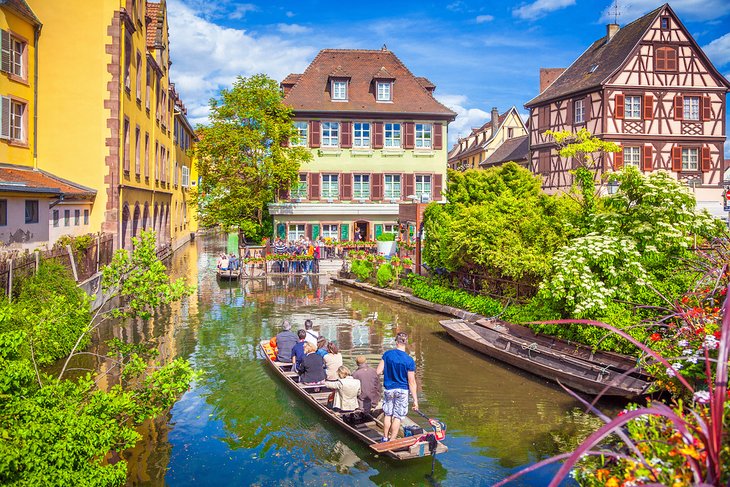
Just past the Rue Saint Jean, the Krutenau Quarter is a picture-perfect neighborhood with canal-side restaurants, quaint pedestrian bridges, and colorful half-timbered houses. Lush greenery and willow trees line the river, while flourishing potted flowers decorate the waterfront houses.
This quarter is known as "La Petite Venise" ("Little Venice") because the houses are built right on the edge of the Lauch River canal, and small boats take passengers on scenic rides.
To soak up the enchanting ambience of Little Venice, begin a walking tour at the Rue de la Poissonnerie and continue along the canal until the Rue Turenne that traverses the quarter.
From the bridges on the canal, you can enjoy lovely views of the quarter's charming houses and the tower of Saint Martin's church in the distance.
Quartier des Tanneurs

A short stroll from the Old Customs House takes you to the Quartier des Tanneurs (the Tanners' Quarter). The aptly named quarter was where tanners created leather products. They would use upper floors of the houses to dry out the skins.
This picturesque neighborhood features cobblestone streets lined with wonderfully restored half-timbered houses dating back to the 17th and 18th centuries. The Petite Rue des Tanneurs and the Rue des Tanneurs are atmospheric streets brimming with lively restaurants and enticing boutiques. The quarter is also traversed by canals, adding to its charm.
Another must-see building in the Quartier des Tanneurs is the Maison des Chevaliers de Saint-Jean (House of the St. John's Knights) on the Rue Saint-Jean, built in the style of a Venetian palace and one of the most unusual Renaissance mansions in Alsace.
Address: Rue des Tanneurs, Colmar
Quai de la Poissonnerie

The district around the Quai de la Poissonnerie is the old fishmonger's district. Centuries ago, professional fishermen were a powerful entity in Colmar and had a bustling business. They fished to the greatest extent possible and stored their catches in fish ponds until they were sold at the market.
This idyllic quarter of colorful half-timbered houses is found between the Quartier des Tanneurs and the Quartier de la Krutenau. Like the Quartier des Tanneurs, this historic area of Colmar is another vestige of the town's ancient professions.
Eglise Saint-Martin
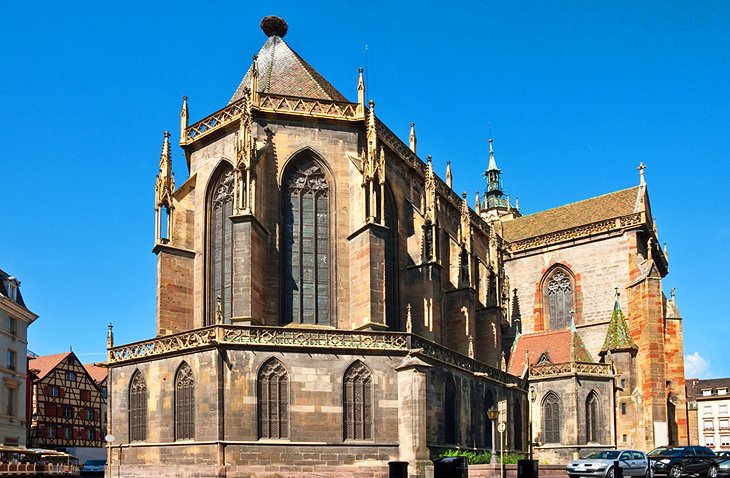
This collegiate church was built between the 13th and 14th centuries and exemplifies Gothic style. The Saint Nicholas Doorway features an intricate design, and the High Gothic choir contains splendid 15th-century stained-glass windows and fine carved woodwork.
The residents of Colmar referred to this church as a cathedral for a long time. However, technically it was only a cathedral from 1790 to 1801, during the Revolution, when the laws of the Civil Constitution of the Clergy applied. Nonetheless, the architecture reflects the grandeur of a medieval cathedral.
The church is located in Colmar's Old Town (Vieux Colmar).
Address: Place de la Cathédrale, Colmar
Eglise Saint-Matthieu

This church has an austere style similar to the Dominican Church. It was constructed by the Franciscans beginning in 1292 and completed over a century later.
When the Franciscan monastery closed in 1543, the building was converted into a hospital. More recently, the church has been used for Protestant worship.
Today, the church is often used as a venue for music concerts because it has excellent acoustics. The Festival International de Colmar in July presents chamber music, symphonic concerts, and classical music recitals within the sanctuary of the Eglise Saint-Matthieu.
Address: 9 Grand Rue, Colmar
Musée du Jouet de Colmar
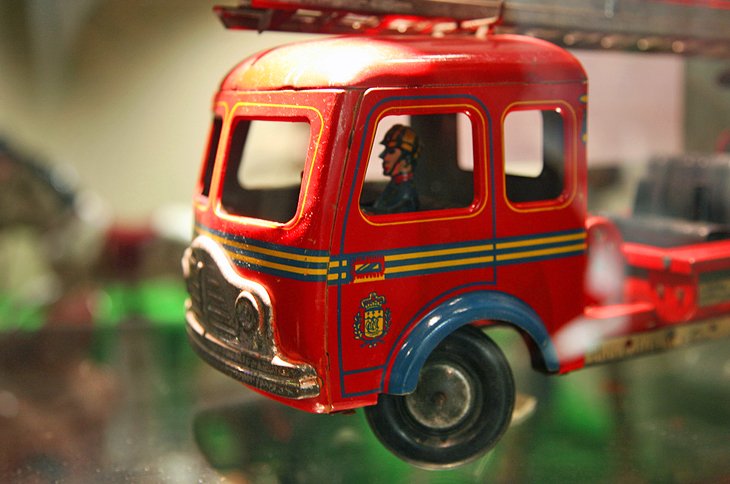
The Colmar Toy Museum displays over 1,000 toys created from the 19th century to the present day. Visitors are delighted by the assortment of dolls, stuffed animals, miniature train sets, model cars, rocking horses, and tricycles. There are also more modern items, such as robots, LEGO creations, and toys that encourage the discovery of science concepts.
Children will especially appreciate the games area, which allows interactive play. For many kids, one of the most amusing things to do at the museum is playing a game of giant checkers.
The museum hosts events, concerts, and temporary exhibitions throughout the year. At the museum's boutique, visitors can purchase toys, books, and games for kids of all ages. Favorite items include the Bukowski teddy bears and Norev model cars.
Address: 40 Rue Vauban, Colmar
Ancien Corps de Garde (Former Guard House)

Built on the site of the Chapel of Saint-Jacques that dates back to 1286, the former Guard House was established in 1575.
Try to spot the oriel window, where the decisions of the town council used to be announced. Another interesting feature of the building is the ornately decorated loggia, which is considered a gem of Renaissance architecture in the Upper Rhine area.
Nearby is the 14th-century Maison Adolph, the town's oldest surviving private house.
Address: 17 Place de la Cathédrale, Colmar
Chapelle Saint-Pierre
This lovely Baroque church was built by the Jesuits in the mid-18th century on the site of the 10th-century Saint Pierre priory.
The church stands beside a peaceful garden. At the center of the garden's courtyard is a monument created by the local sculptor Bartholdi dedicated to the Colmar physicist G. A. Hirn (1815-1890).
The church is found near the Quartier de la Krutenau past the Grand Rue.
Address: Boulevard du Général Leclerc, Colmar
Festival International de Colmar
The Festival International de Colmar gives classical music lovers a reason to visit Colmar during the first two weeks of July.
This renowned festival includes daytime chamber music concerts by composers such as Bach, Beethoven, Schumann, and evening soirées (orchestra performances or piano recitals) presenting pieces by Berlioz, Mozart, Brahms, Mendelssohn, and others.
Performances take place at the 18th-century Chapelle Saint-Pierre and the 14th-century Eglise Saint-Matthieu.
Map of Tourist Attractions in Colmar
More Related Articles on PlanetWare.com
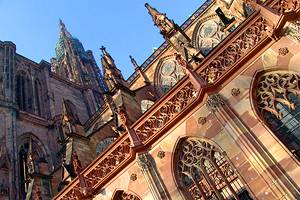
Colmar is an ideal place to begin a tour of the beautiful Alsace region in eastern France bordering Germany. Tourists will enjoy visiting the important historic towns, such as Strasbourg, Obernai, and Sélestat. It's also delightful to experience the region's quaint country charm, by venturing out into the hills, where storybook hamlets and picture-perfect villages dot the idyllic landscape.
